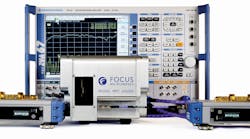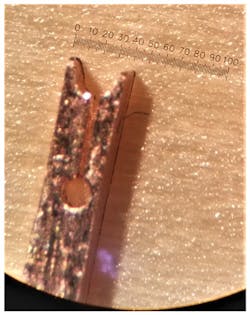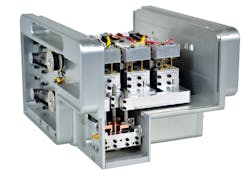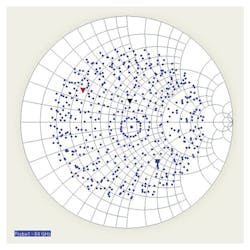This file type includes high resolution graphics and schematics when applicable.
Impedance tuning makes it possible to determine accurately how an active device will behave under different source and load conditions. This is also becoming increasingly important at millimeter-wave frequencies, since spectrum has been largely licensed and consumed for different applications at lower frequencies.
As applications like automotive radars and Fifth-Generation (5G) wireless networks look to frequencies at 60 GHz and beyond, impedance tuners are a means of finding impedances for optimum noise and power performance of the active devices for amplifiers in those applications. To meet these needs, an extension to 110 GHz of the Multi-Purpose-Tuner (MPT) line of coaxial harmonic impedance tuners from Focus Microwaves was developed for 5G applications at a fundamental frequency of 28 GHz and harmonics at 56 and 84 GHz.
This extension is a unique impedance-tuning solution with the flexibility to perform source- or load-pull on-wafer and in-fixture measurements. It enables separate changing of impedances at fundamental and harmonic frequencies at literally millions of impedance points.
The new, higher-frequency impedance tuners, such as the 20- to 110-GHz MPT-110200 tuner (Fig. 1), are designed for broadband, non-50-⦠measurements on millimeter-wave devices, using three independently controlled, precision tuning probes (Fig. 2). The three probes slide along a common slotted airline (slabline) and approach the center conductor, changing the impedance at any three user-selected harmonic frequencies from 20 to 110 GHz without external hardware interventions.
The tuner’s design allows the probes to be withdrawn from the airline, for a return to a 50-⦠test environment. (Note: The MPT tuner technology is protected by U.S. patent Nos. 7,135,941; 8,188,816; 8,212,628; 8,400,238; 8,405,475; and 8,629,752.)
Such impedance tuners can vary the impedance either at the source or at the load of a device under test (DUT). When used at the source, for small-signal measurements, the noise characteristics of a DUT can be analyzed when attempting to find, say, the input impedance match that provides lowest noise figures over a bandwidth of interest.
When used at the load, for load-pull testing, impedance tuners help find which fundamental and harmonic impedances deliver the best DUT output performance. They do so in terms of such parameters as output power at 1-dB compression, gain, power-added efficiency (PAE), adjacent-channel power ratio (ACPR), and error vector magnitude (EVM).
In addition, an MPT-110200 tuner can generate the high VSWRs needed to perform prematching of an active device for optimum performance under certain conditions, such as when operating with a reduced power supply.
Some device behavior, such as output power, can be analyzed with a test setup that adds standard test instruments—e.g., a signal generator—to drive the input and a power meter and sensor to measure power at the output. However, noise analysis and more detailed load-pull measurements require a microwave vector network analyzer (VNA) to provide S-parameter displays of amplitude and phase and Smith charts that can show the effects of changing impedance on DUT behavior.
Load-pull contours can be shown on a Smith chart to gain an understanding of device behavior at different impedances. It also makes it easier to find impedance matches for best gain, output power, compression behavior, PAE, and error vector magnitude (EVM); as well as the matching load impedance for a given device that best optimizes the different parameters at different frequencies.
In developing the MPT-110200 tuner, an upgraded (to 110 GHz) version of the ZVA 67 VNA from Rohde & Schwarz was instrumental in characterizing and calibrating the tuner system over extremely wide operating frequency ranges. The display screen of the ZVA 67 VNA in the test system of Fig. 1, for example, shows the frequency response (amplitude versus frequency) of the tuner system. Markers are set at a fundamental frequency of 28 GHz and second- and third-harmonic frequencies of 56 and 84 GHz, respectively.
As is often the case at higher frequencies, the excellent broadband frequency response of the probes owe a great deal to mechanical design and fabrication, and the millimeter-wave frequency response of the MPT-110200 system would not be possible without the tight machined tolerances of these slug tuners. Especially at the smaller wavelengths (λ) of millimeter-wave frequencies (λ/2 at 84 GHz = 2 mm), machined tolerances and motion control in mechanical slug tuners are critical to maintaining repeatable impedance behavior.
The design of the MPT-110200 involves cascading three separate vertically and horizontally adjustable broadband impedance probes and maintaining consistent broadband reflection factor (Γ) across the full Smith chart. The independent movement of the probes is under stepper-motor control, with the probe movements orchestrated by a computer running custom C++ and C# MPT software.
The software for the MPT tuners includes a proprietary calibration routine that enables the generation of approximately 1 billion possible combinations of impedance points for each set of harmonic (fundamental, second harmonic, third harmonic) frequencies in less than 30 minutes. A full calibration of an MPT system is saved in a tuner calibration structure file of typically only 60- to 120-kb memory, whereby the billions of tuning permutations occur in real time using high-speed random access memory (RAM).
A glance at the internal works of an MPT-110200 tuner system (Fig. 3) reveals the intricacy of the mechanical detail and the electronic control systems needed to achieve probe movement. It also shows the fine steps needed to provide fine resolution and control of impedances at three different frequencies and across a frequency range from 20 to 110 GHz.
While it is not trivial to incorporate three cascaded impedance tuners within a common enclosure, as in the MPT-110200, the relatively compact size of the tuner system achieves several goals. It reduces the signal transmission path (and thus the loss) between the impedance tuner and the DUT; it helps to increase the tuning range; and it simplifies the placement of the tuner system when it must be mounted onto an automated on-wafer measurement system.
As with other MPT systems, the MPT-110200 tuner can be set in a high-VSWR mode or in a harmonic mode, providing choices in impedance tuning ranges for flexibility in impedance tuning and matching at fundamental frequencies and at harmonic frequencies. The millimeter-wave frequency range of this particular tuner system (Fig. 4) makes it a candidate for behavioral modeling of active devices that will be needed for signal amplification in many emerging millimeter-wave applications, including for 5G backhaul links and short-range communications.
Why Use Harmonic Tuning?
Wireless communications have undoubtedly become a staple of many modern lives, whether for personal entertainment, business, or even military applications. The complex demands of modern communications systems—the need to provide outstanding performance at low power levels and achieve maximum operating times on battery power—have pushed a growing number of circuit designers toward impedance tuners (in particular, harmonic impedance tuners) as a means to gain optimum performance from discrete devices and integrated circuits (ICs).
By understanding the behavior of an active device in non-50-⦠environments—not only at fundamental operating frequencies, but at second- and third-harmonic frequencies—the impedance matching circuitry around the device, and even the manner in which the device is biased, can be fine-tuned for best performance.
Circuit designers have learned how to use device energy produced at second- and third-harmonic frequencies to improve PAE and EVM. This feeds back the energy at the harmonic frequencies with changes in phase to help cancel unwanted spurious signals and improve the efficiency of the active device, in an operation known as “waveform engineering.” This also reduces operating power requirements. (For a short history on the development of harmonic impedance tuners, see “The Evolution of Harmonic Load Pull.”)
This “waveform engineering” design trend becomes even more critical at higher frequencies, with 60 GHz, for example, being one of the proposed bands for short-haul wireless links in 5G wireless communications networks. Available signal power tends to decrease with increasing frequencies, requiring cost-effective amplification (and effective impedance matching) at millimeter-wave frequencies. Harmonic impedance tuners should become increasingly more common in microwave test labs as the move to using higher frequencies continues.
Admittedly, the MPT-110200 tuner is just one step in that direction, with more to follow at even higher frequencies. Nevertheless, the broadband tuner system will provide essential insights into device behavior through 110 GHz and offer a sound starting place for many active circuit designers.
Focus Microwaves Inc., 1603 St. Regis, Dollard-des-Ormeaux, Quebec H9B 3H7, Canada; (514) 683-4554
This file type includes high resolution graphics and schematics when applicable.





